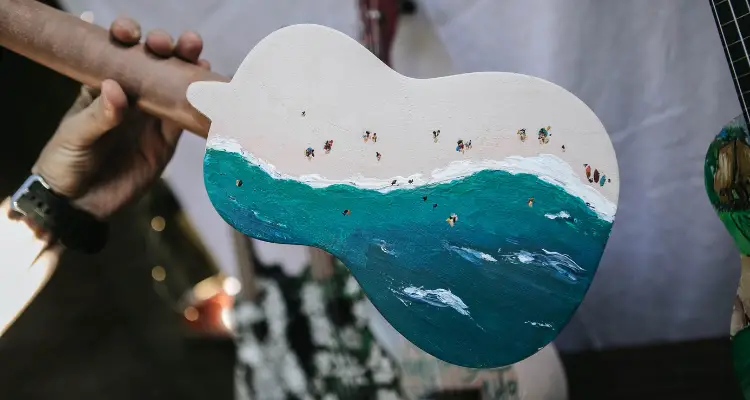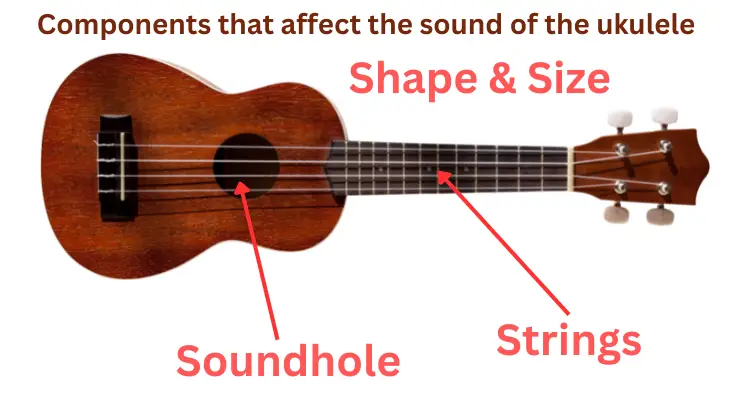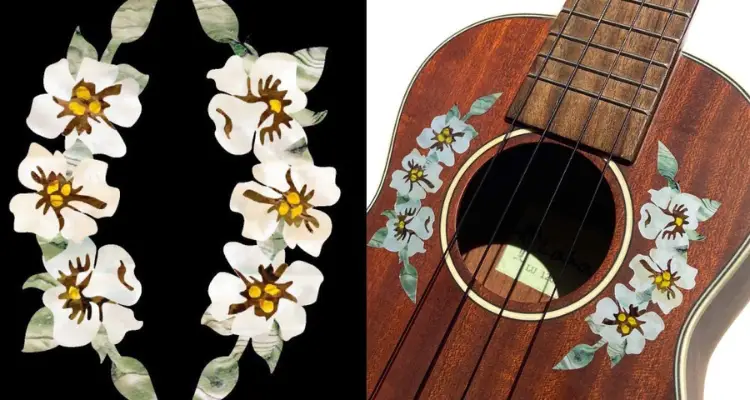Painting a ukulele does not ruin but alters the sound if you use too many layers of paint especially thick acrylic paint. It may make the sound like a drum or a box.
To avoid changing the ukulele sound you should paint in thin layers and should not paint more than 1-2 layers.
In this article, you will get all the information about painting a ukulele. Like – which type of paint to use, how to prepare your ukulele for painting and repainting etc.
So, without further ado let’s get started.
Contents
- Should You Paint Your Ukulele?
- Mechanics of Ukulele Sound Production
- Pros and Cons of Painting a Ukulele
- What Paint Should You Use for Ukulele?
- Step-by-Step Guide to Prepare a Ukulele for Painting
- Is It Ok to Repaint a Ukulele?
- Do Stickers Affect the Sound of a Ukulele?
- Can You Customize Ukulele?
- Conclusion
Should You Paint Your Ukulele?
Yes, you can paint your ukulele, but you have to compromise with some sound alteration.
If you want to paint your ukulele for fun and changing in sound does not affect you then go ahead and start painting your ukulele.

Here are some tips to keep the sound changing minimum:
Disclosure: This post may contain affiliate links, which means we may receive a commission if you click a link and purchase something that we recommended. Read more about Affiliate disclosure here.
- Avoid painting the inside of the instrument or the bridge. It can significantly impact the sound of your ukulele.
- Always apply a thin coat of paint and choose a high-quality, low-density paint to minimize sound changing.
- Don’t paint over the soundhole. This can impact the original sound of the instrument.
- I don’t recommend sanding or removing old paint but if you want always go ahead with caution. Any damage or alterations to the wood can dramatically impact the sound quality.
- If you want to customize without changing the sound of the ukulele then you can use a removable, non-permanent method of customization such as decals or stickers.
- If your ukulele is under warranty, painting it may void its warranty, so be sure to check with the manufacturer before making any modifications.
Mechanics of Ukulele Sound Production
Before any customization, you should know about the mechanics of ukulele sound production. It can help you better appreciate and optimize the sound of your instrument.
Here is the Mechanics:
When you pluck a ukulele string, it vibrates back and forth and creates sound waves that travel through the air.
The sound waves are then resonated by the hollow wooden body of the instrument and amplified.
Components that affect the sound of the ukulele:

- Strings: Strings play a big role in the dynamics of the sound. Thick strings produce a loud and rich sound, while thin strings produce a bright but more delicate sound.
- The length of the strings affects the pitch of the sound they produce. Such as when we hold strings on the fretboard the length of the strummed strings changes and the pitch shifts to higher notes.
- Shape and Size: The shape and size of the ukulele also matter a lot. Such as the baritone ukuleles which are 29 inches long, have more air volume inside hence producing fuller and deeper sound. Shape of the body, specifically the curvature of the tonewood, also affects the tone and volume of the sound.
- Soundhole: Soundhole is another important component of ukulele’s sound production. It allows sound waves along with the air volume to escape from the body and we listen to this sound.
Pros and Cons of Painting a Ukulele
There are some pros and cons of painting a ukulele that you must know if you are planning to paint your ukulele.
Pros:
- Personalization: Painting your ukulele allows you to personalize it according to your personal style and make the instrument unique and presentable.
- Aesthetics: Artistic paint job can make your ukulele look visually stunning and eye-catching, and people notice your ukulele during performances.
- Protection: Painting your ukulele can provide a layer of protection against scratches, weather changes, and other types of damage.
Cons:
- Sound Quality: Painting your ukulele can alter the sound of your ukulele. It adds weight and density to your instrument. And you will face a change in tone or volume.
- Difficulty: Painting a ukulele yourself is a challenging task, especially if you don’t have experience with painting or woodworking. If you do not do it properly, it can severely affect the sound quality and durability.
- Void Warranty: If your ukulele is in the warranty period then painting it may void its warranty, so be sure to check with your ukulele manufacturer before painting it.
What Paint Should You Use for Ukulele?

A thin layer of acrylic paint is the preferred type of paint to paint the ukuleles.
Well, if you have already decided to paint your ukulele then you must choose the right paint to ensure the best possible results.
Here are some tips to choose the right paint for your ukulele:
- You should choose a paint that is specifically designed for stringed instruments. It ensures that the paint will stick properly to the surface of the ukulele without affecting the sound quality.
- You must choose a low-density paint that won’t add too much weight to the instrument. Due to extra weight dense paints can impact the sound quality of the ukulele.
- Use water-based acrylic paint. Acrylic paints are less toxic than oil-based paints and easier to clean up during maintenance.
- Only go for high-quality paint that is durable and long-lasting to help ensure that the paint doesn’t fade and looks good for years.
- Use a primer before applying the paint to ensure a smooth and even finish.
- If you are not sure about using the right type of paint consult with a professional.
Step-by-Step Guide to Prepare a Ukulele for Painting
To paint a ukulele you have to prepare to achieve the best possible results.
Here is the step-by-step guide to preparing your ukulele for painting:
- Disassemble the ukulele: Remove the strings, bridge, and other components that may interfere with the painting process.
- Clean the surface: To clean the surface of the ukulele use mild soap and warm water. Make sure to remove dirt, grease, etc.
- Sand the surface: Use a fine-grit (150-180) sandpaper to lightly sand the surface of the ukulele. This will give the paint a smooth finish.
- Apply a primer: Apply a THIN LAYER of primer to the surface of your ukulele. Primer will create a smooth base for the paint.
- Sand the primer: You have to sand again once the primer becomes dry.
- Apply the paint: Use a small brush or a spray gun to apply the paint to the surface of your ukulele. Apply the paint in thin and even coats. Allow each coat to dry completely before applying the next. Try not to apply more than two coats.
- Apply a protective finish: When the paint becomes dry, apply a protective finish to the surface of the ukulele. This protective finish will protect the paint and create a durable, long-lasting finish. Polyurethane wood finishes are great to finish your ukulele.
Is It Ok to Repaint a Ukulele?
This is a subject of debate and already people are divided into two parts regarding the repainting of ukuleles and guitars.
For me, yes, it is okay to repaint your Ukulele, however, there are some things to consider before painting.
Repainting a ukulele PROFESSIONALLY can potentially impact the ukulele’s sound. Paint can add extra weight and density to the instrument which can alter the sound quality.
Any experienced ukulele player may notice a difference in the sound after repainting your ukulele.
Also, modifying your ukulele by repainting it can decrease its resale value. It particularly applies to rare or vintage instruments.
If your ukulele is rare, vintage, or has sentimental value, then I recommend you to think twice before painting it.
Get advice from a professional or experienced ukulele player before painting your ukulele. They may give you better advice about it.
Do Stickers Affect the Sound of a Ukulele?

If you don’t want to paint your ukulele then the second option is stickers. Stickers are a popular way to customize and personalize ukuleles.
However, it also has an impact on the sound of the ukulele. Stickers may impact the vibration of the ukulele’s soundboard.
When you apply a sticker to the surface of the ukulele, it changes the way the sound waves travel through the wood. As a result, it may alter the resonance and tone of the instrument.
However, adding one or two small strikers may not affect your ukulele’s sound a lot, but if you are using multiple stickers on the soundboard that adds extra weight to the ukulele, which can affect its sound.
So, I recommend, don’t add too many stickers on the ukulele’s body. One or two may be fine for enhancing the style but overusing the sticker may affect the sound severely.
Can You Customize Ukulele?
There are several things that come with customizing a ukulele.
Such as,
- Changing the strings
- Adding accessories such as stripes, etc.
- And painting your ukulele
If you are changing the strings from nylon to fluorocarbon or steel, keep in mind that each of these produces a different sound and feel. If you are ready to accept the alteration in sound then you can go ahead and change the strings.
Otherwise, you can add accessories, such as straps, stickers, and decals to your ukulele to make it more appealing and attractive. Adding any accessories to the body can affect the sound quality.
You can also paint your ukulele but painting a ukulele has its own demerits.
So, the best thing is, you may order from a manufacturer for a customized ukulele or buy a custom-made ukulele from the manufacturer.
Conclusion
Painting a ukulele can affect its sound, but will not ruin it if handled with care.
Changing in sound depends on multiple things such as which type of paint you are using, the process, and how thick the paint layer is.
These all play a role in how the sound will be affected.
If you can digest the unique sound that a painted ukulele produces then go and paint your ukulele.
And if you like the natural sound of the ukulele then don’t do it.
For me, I like the natural sound of the ukulele that’s why I don’t prefer to paint my ukulele.
Related,
